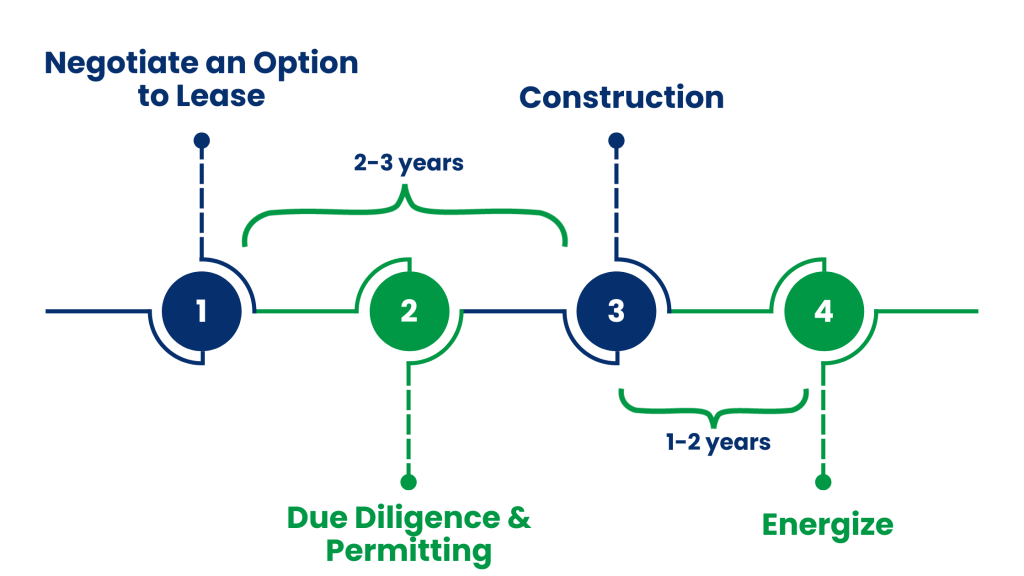Your Land, Our Expertise
The choices you make today set the foundation for tomorrow. Partner with GSI to transform your underutilized, vacant or environmentally impacted land into a thriving renewable energy project.
With a proven track record of over 40 operational projects, GSI brings unmatched expertise to every step of the development and construction process. From concept to completion, we turn possibilities into reality, creating sustainable solutions that benefit you and your land.
Let’s build a greener future – together.
Why Host a Project?
-
- Enjoy consistent, long-term, annual lease payments.
- Let’s co-exist! Renewable energy projects are designed to co-exist with your land, allowing you to maintain other agricultural or conservation practices.
- Support clean energy by contributing to your state’s sustainability goal.
- Turn unused space into a revenue generating, renewable energy powerhouse by hosting a solar project on your brownfield or landfill site.
Let your land work harder for you – generate income, protect the environment, and secure a legacy of sustainability.
Project Roadmap

Frequently Asked Questions
Safety
Q: Does a solar project have a negative impact on my land or livestock?
A: A well-managed solar project has minimal to no negative impact on land or livestock. Solar panels are passive structures that do not emit harmful chemicals or noises. In addition, solar farms are designed to safely co-exist with livestock. Many farms allow grazing beneath solar panels, which can benefit both land and animals by providing shade and maintaining vegetation.
Project Schedule
Q: What is a standard construction timeline for a solar project?
A: Development and construction timelines vary based on project size, location, site conditions, regulatory requirements and weather conditions during construction. Typically, the development phase, which includes time required to perform due diligence and secure state and municipal permits, will require 18-36 months. Construction will range from approximately 6-months for a 5MW project or closer to 12-months for a 100MW project.
Maintenance
Q: Who will be responsible for managing and maintaining this project during operation?
A: GSI is responsible for managing and maintaining all projects. GSI has a dedicated Operations & Maintenance (O&M) team responsible for the ongoing maintenance of the solar equipment ensuring efficient operation and addressing any technical issues. Our team is also responsible for re-vegetation and weed management.
Stewardship of the Land
Q: Will my land be protected during and after the full life cycle of this project?
A: Stewardship of your land is our #1 priority. To ensure adequate protection of your land, GSI prides itself in being a reputable company that implements best practices to minimize land disturbance and preserve soil health and local ecosystems. A comprehensive decommissioning plan is necessary and at the end of the project lifecycle, it will serve as a guide for our team in the removal process of all solar equipment to ensure the land is returned to its original state.
Financial
Q: What is the lease term and monetary consideration?
A: The operation period is 20+ years with the possibility of extending this period for an additional 10-20 years. Landowners typically receive annual lease payments, structured as a per acre rate, depending on location, market rates and project size. The lease rate will be influenced by your site’s location, the local utility interconnection costs, on-site land features, federal tax incentives, and local state renewable energy policies. With your site details, we can analyse these considerations and provide a financial offer quickly.
Benefits of Solar Power
Q: Who benefits from the energy produced once the solar project is up and running?
A: The benefits from solar energy production extend to many stakeholders. Utility companies purchase the power to distribute to their customers and benefit from power generation supply diversity and less reliance on volatile pricing of fossil fuels. Communities benefit from locally generated clean energy, job creation during construction and operation, property tax revenue, and enhanced grid reliability.
Interested in leasing your land?